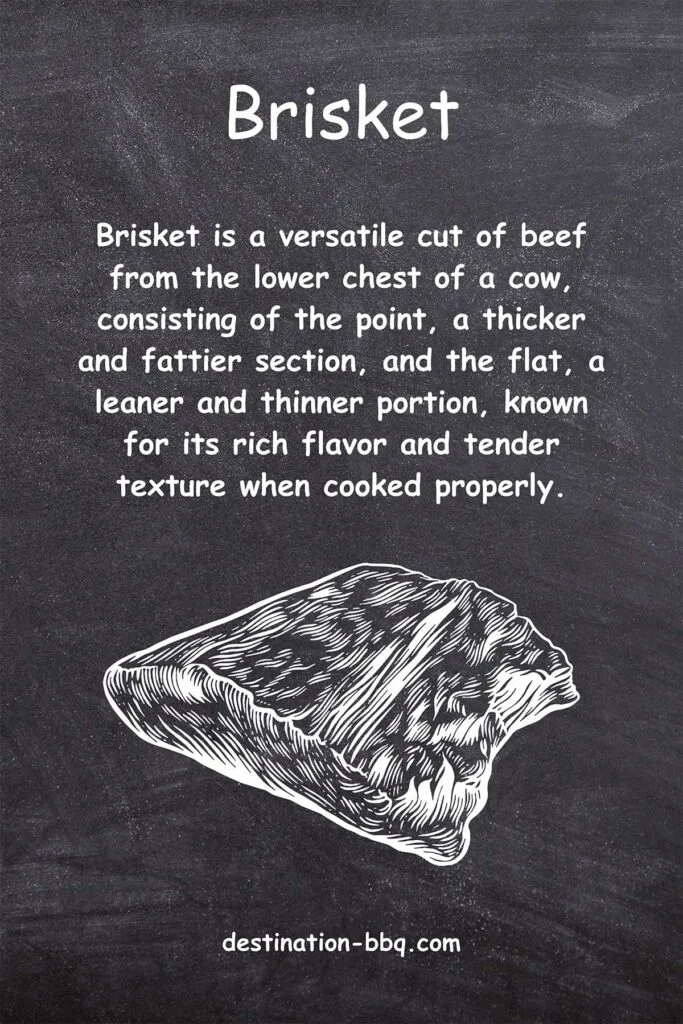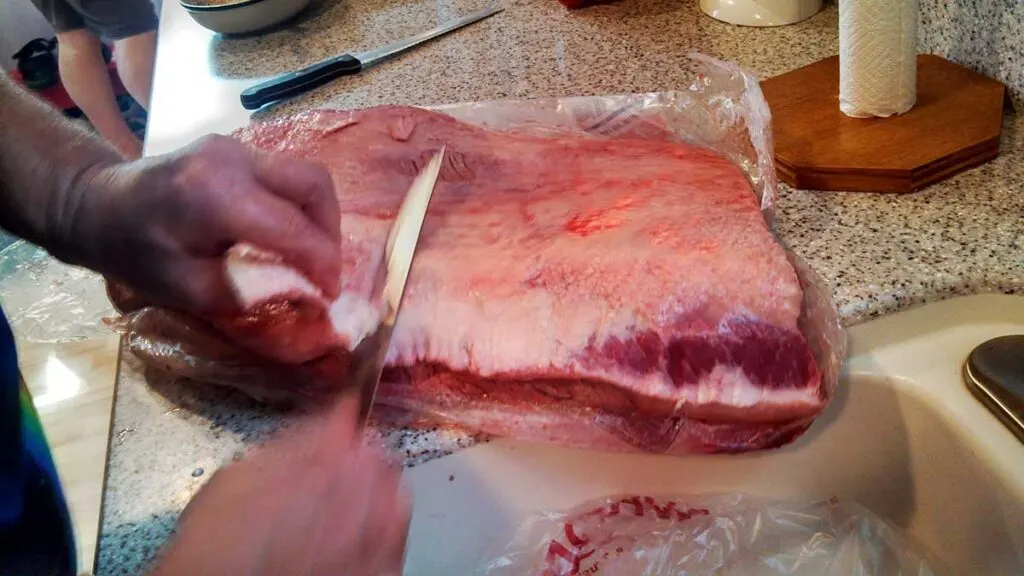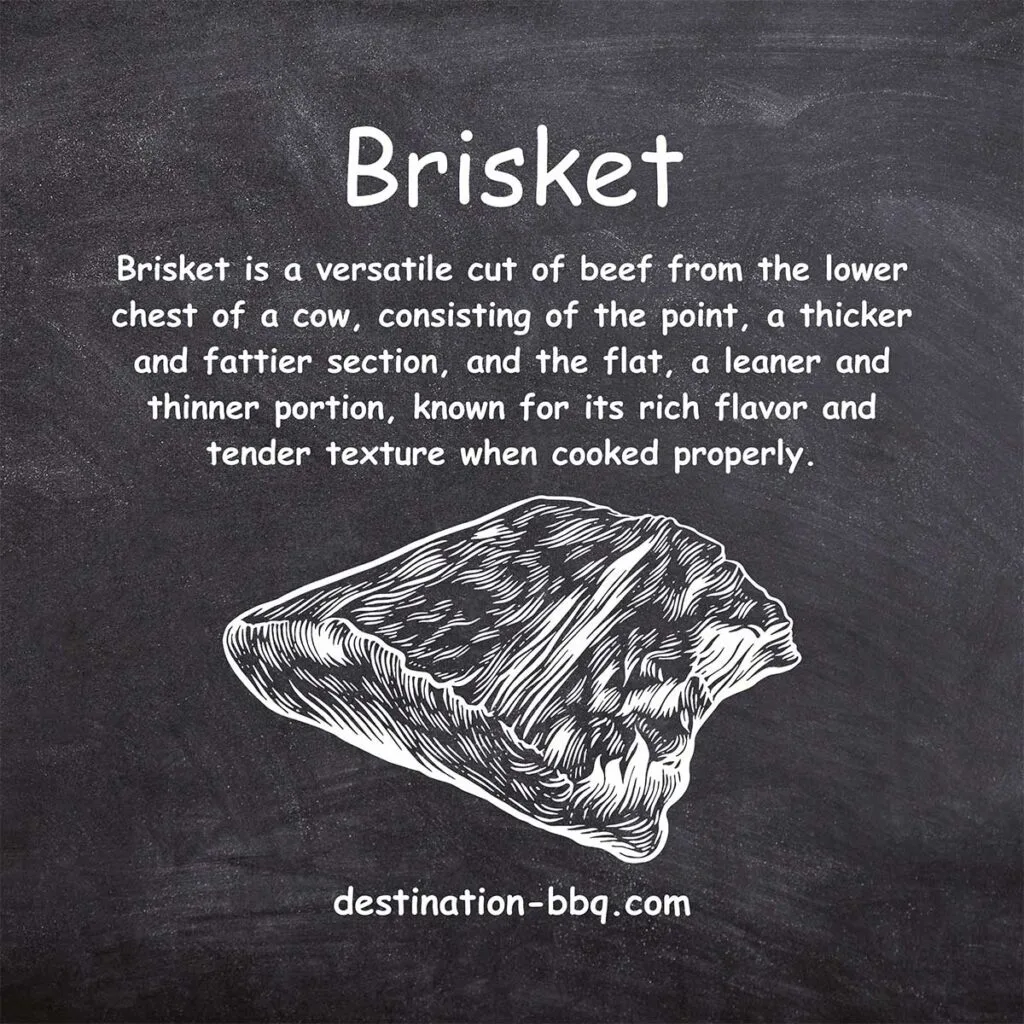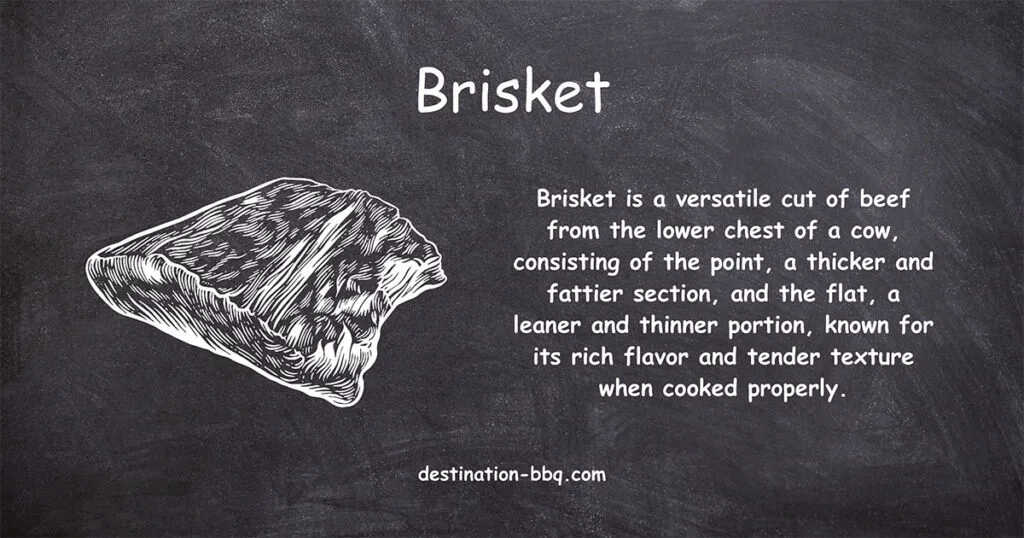
What is Brisket?
Brisket is a popular cut of beef derived from the lower chest or breast of a cow, specifically from the superficial and deep pectoral muscles that bear a significant portion of the animal’s body weight.
The cut, which weighs between 10 to 14 pounds, is typically divided into two main parts: the leaner “flat” or “first cut” and the fattier “point” or “second cut”.
Known for its versatility, brisket is used in a variety of dishes, including corned beef, pastrami, and smoked barbecue, and it can be prepared through several cooking methods such as smoking, braising, oven roasting, and slow cooking.
Key Takeaways
- Brisket is a cut of beef from the breast or lower chest of a cow, comprised of two muscles (superficial and deep pectoral), making it one of the nine primal cuts of beef.
- There are two main cuts of brisket: the “flat” cut (leaner, thinner, with consistent thickness) and the “point” cut (thicker, fattier, with more marbling and connective tissue).
- Brisket can be cooked using various methods including smoking, braising, oven roasting, and using a slow cooker; each method enhances its tenderness and flavor.
- Before cooking, brisket is typically trimmed and seasoned; after cooking, it should rest before slicing, and it’s usually served with or without a sauce, depending on personal preference.

“Brisket is one nasty cut of meat. It will fight you ferociously as you try to tame it. Once you do, though, it lays down like a cuddly puppy and rewards you with a big, delicious hug.”
— Danny Meyer, restaurateur and Shake Shack sheik
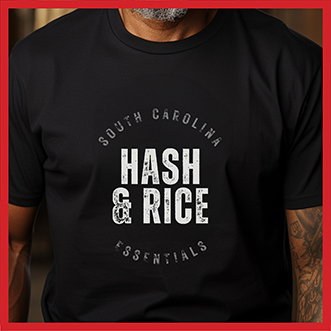
Gifts for Your Favorite Pitmaster
(even if that’s you!)
On
Etsy
Shirts, hats & more designed exclusively by Destination BBQ
Understanding Brisket
Brisket is a popular cut of meat that comes from the breast or lower chest of a cow. Known for its rich flavor and tender texture when cooked properly, this versatile cut has become a staple in various cuisines and cooking methods.
As one of the nine primal cuts of beef, the brisket is a significant part of the cow’s anatomy, consisting of the superficial and deep pectoral muscles that support about 60% of the body weight of standing or moving cattle.

JoeSmack, Public domain, via Wikimedia Commons
A full brisket can weigh between 10 and 14 pounds and is composed of two overlapping muscles.
The “flat” or “first cut” is the thinner, leaner portion of beef brisket, while the “point,” also known as the “deckle point” or “second cut,” is the thicker and fattier section.
This cut of meat has various uses in dishes, such as corned beef, pastrami, and smoked barbecue, making it an essential ingredient for chefs and home cooks alike.
Anatomy of Brisket
Brisket is a popular cut of meat that comes from the lower chest or breast of a cow. It has gained recognition in various recipes and culinary techniques worldwide. In this section, we will explore various aspects of brisket, including its position among beef primal cuts, its composition in terms of pectoral muscles, and the different types available – the flat cut and the point cut.
Beef Primal Cuts
Beef brisket is classified as one of the nine beef primal cuts (see illustration above), which are the primary divisions of meat obtained from a cow. The definition of these cuts may slightly vary, depending on the region. Brisket’s primal cut category implies its importance in the beef industry and highlights its distinct characteristics that set it apart from other cuts.
Pectoral Muscles
The brisket consists of both superficial and deep pectoral muscles of the cow. These muscles play a vital role in supporting a significant portion of the animal’s body weight, especially during standing or moving. The high level of connective tissue in this area makes brisket a tougher and more fibrous cut of meat.
John Lewis, of Lewis Barbecue in Charleston and Greenville, agrees, noting the following:
“The brisket is the toughest piece of meat basically on the cow. And it takes a long time at a really low temperature to break down all those connective tissues in it that are tough and to end up with something that’s a silky juicy piece of beef.”
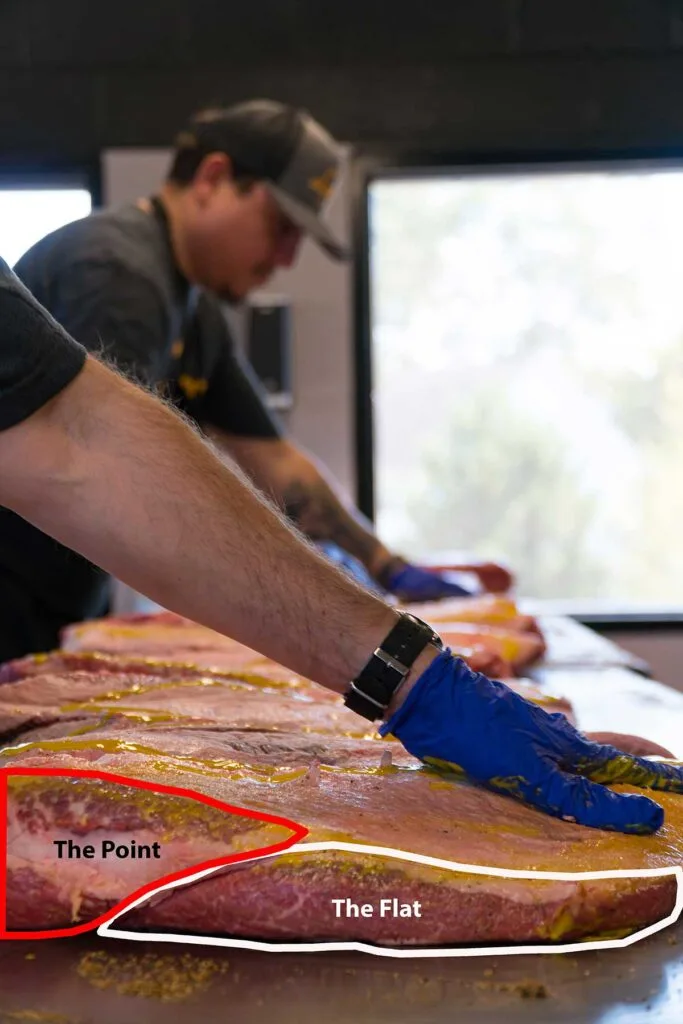
Original photo courtesy of Lewis Barbecue. ProBros, photographer.
Flat Cut and Point Cut
Brisket can be further divided into two main cuts: the flat cut and the point cut.
Flat Cut: Also known as the first cut, the flat cut is a leaner and thinner cut, with a consistent thickness throughout and a uniform layer of fat on one side. This cut is ideal for slicing and is commonly used in recipes requiring evenly-sized, lean pieces of meat.
Point Cut: The point cut, on the other hand, is thicker and has more marbling and connective tissue. It is typically used when a more tender cut with more flavor is desired. Due to the additional fat and marbling, the point cut may take longer to cook using low and slow techniques such as braising or smoking.
In short, brisket is a versatile and delicious cut of beef that offers various cooking options and flavors. Understanding its composition and the difference between the flat and point cuts can help cooks make informed choices about using it in different dishes.
Cooking Methods
When it comes to cooking brisket, there are several methods that can be used to achieve a tender and flavorful result. Those familiar with brisket as barbecue will always use the smoking method, but for non-barbecue options for brisket, there are several other cooking techniques to help render this tough piece of meat.
Below, we’ll discuss the four main cooking techniques: Smoking, Braising, Oven Roasting, and Slow Cooker.
Smoking

Photo courtesy of Lewis Barbecue. Savannah Bockus, photographer.
Smoking is a popular method for cooking brisket, especially in barbecue culture. This low-and-slow technique uses indirect heat and smoke from hardwoods, such as hickory or mesquite, to impart a rich, smoky flavor to the meat.
To smoke a brisket, you will need a smoker, charcoal or offset grill, or yes, even a gas grill with a dedicated smoking section and a drip pan filled with water.
Begin by trimming and seasoning your brisket with a flavorful dry rub or spice rub.
Prepare your smoker by bringing it to a consistent low temperature, typically around 225-250 degrees Fahrenheit. Place the brisket in the smoker with the point end towards the heat source. This is because the point can handle more heat than the flat and it helps to prevent the brisket from drying out.
Maintain a consistent temperature and smoke with hardwood, like oak or hickory, for the best flavor. The brisket is typically smoked until it reaches an internal temperature of about 195-203 degrees Fahrenheit. This process can take anywhere from 12 to 20 hours depending on the size of the brisket.
Like with the 3-2-1 method for ribs, many pitmasters wrap brisket (aka Texas Crutch) in foil or butcher’s paper for part of the cook.
Once the brisket reaches the desired internal temperature, remove it from the smoker and let it rest for at least an hour before slicing. This allows the juices to redistribute throughout the meat, resulting in a juicier brisket.
Braising
Braising is a technique that involves cooking meat in a small amount of liquid, usually in a Dutch oven or a deep roasting pan. This method is excellent for tenderizing brisket and enhancing its natural flavors.
Begin by searing the brisket in a hot pan to develop a caramelized crust. Then, transfer it to a Dutch oven or roasting pan, along with vegetables and a flavorful sauce or braising liquid.
Cover and cook the brisket at a low temperature (approximately 225°F) for a few hours until tender. The cooking time for a brisket flat or point may take around 3 to 3 1/2 hours, while a whole brisket may require an extra hour.
Oven Roasting
Oven roasting is another method to cook brisket that allows for a slow, low-temperature cooking process. To begin, preheat your oven to 275°F. Sear the brisket in a hot pan to develop a caramelized surface before transferring it to a roasting pan.
For optimal results, double-wrap the brisket in aluminum foil, along with vegetables and sauce, to retain moisture and ensure even cooking. Bake the brisket in the oven for several hours until the meat is tender, checking for an internal temperature of 185°F to 190°F.
Slow Cooker
A slow cooker is a convenient and effective way to cook brisket, producing a tender and flavorful result. Place your seasoned brisket in the slow cooker, fat-side up, along with a sauce or liquid of your choice. Set the cooker to low and cook the brisket for 6 to 8 hours until it reaches an internal temperature of 185°F to 190°F.
This method is particularly useful for recipes that call for corned beef or pastrami, as the low and slow cooking process helps break down the connective tissues, providing a tender final product.
Selecting and Preparing Brisket
Buying Tips
When selecting a brisket at a grocery store or from a butcher, it’s best to choose a cut with a good balance of fat and lean meat. A whole brisket is made up of two muscles, flat and point, overlapping each other.
The point is often more heavily marbled with fat and is great for dishing up tender, juicy burnt ends. The flat is more uniform in thickness and has less fat, making it ideal for slicing and serving at a BBQ or holiday dinner like Rosh Hashanah.
Make sure your cut has a relatively even, thick fat cap, which will protect the meat as it cooks. Opt for a center cut or second cut if available, as these have a better fat-to-meat ratio. Some pitmasters prefer higher quality cuts, such as Wagyu brisket, for a richer, more decadent outcome.
Trimming
Before cooking, trim the fat cap to about 1/4 inch (0.6 cm) thick, ensuring even cooking and easier slicing when done. Removing excess fat from the outer perimeter of the brisket allows the seasonings to penetrate the meat and promotes the formation of a savory crust.
Be careful not to over-trim, as too little fat can lead to a dry, tough brisket. You may also want to remove the deckle, a fatty, gristly piece connecting the flat and point.
Aaron Franklin’s Advice on Trimming Brisket
Aaron Franklin is likely the most well-known and respected pitmasters in all of Texas, where brisket reigns as king. In fact, Franklin is the first and only pitmaster to teach a BBQ course on Masterclass, and it’s worth watching.
As mentioned above, trimming is, in part, about getting to the ideal amount of fat for a good cook.
As Franklin said, “If you don’t trim the fat off of it, it’s likely gonna end up too fatty after you cook it, or if you trim too much off, and then you try to cook it it’s gonna run out of fat, and it’s gonna be dry.”
Here are several additional tips he shares in Masterclass and on other videos about trimming brisket.
- Open a vacuum-sealed brisket by slicing up through the plastic, blade facing up away from the meat. Do this on the fatty side to protect the meat from accidental damage.
- Use a curved boning knife to trim with, the tip is flexible, but toward the hilt, it is sturdy. (This Weige brand knife is the one he uses in his course. This much less expensive knife is like the one Franklin’s dad gave him and that he uses in the restaurant and in his PBS video to trim brisket.)
- Trim brisket when it is really cold. The colder the better. When the fat gets warm, it gets sticky and makes it difficult to trim.
- Aim to leave about a quarter-inch of fat on the brisket. If you leave too much, it will be too fatty after cooking. If you trim too much, it may dry out during cooking.
- Trim the deckle (a layer of hard fat and connective tissue located between the point and the flat). It’s not likely to render out during cooking.
- Remove any parts that are very thin or stick out as they are likely to burn during cooking
- Trim off any silver skin on the bottom of the brisket. You can trim as much or as little as you want.
- After trimming, the brisket should have about a quarter-inch of fat all the way across and be shaped aerodynamically.
Seasoning
To enhance the flavors of the brisket, season it thoroughly. A simple rub of salt and pepper will suffice for traditional Texas-style smoked brisket.
However, feel free to experiment with other herbs, spices, and seasoning blends to suit your taste preferences. Apply the rub evenly to the entire surface of the meat, including the fat cap, before cooking.
John Lewis uses an unusual combo before seasoning his brisket, pickle juice and mustard.
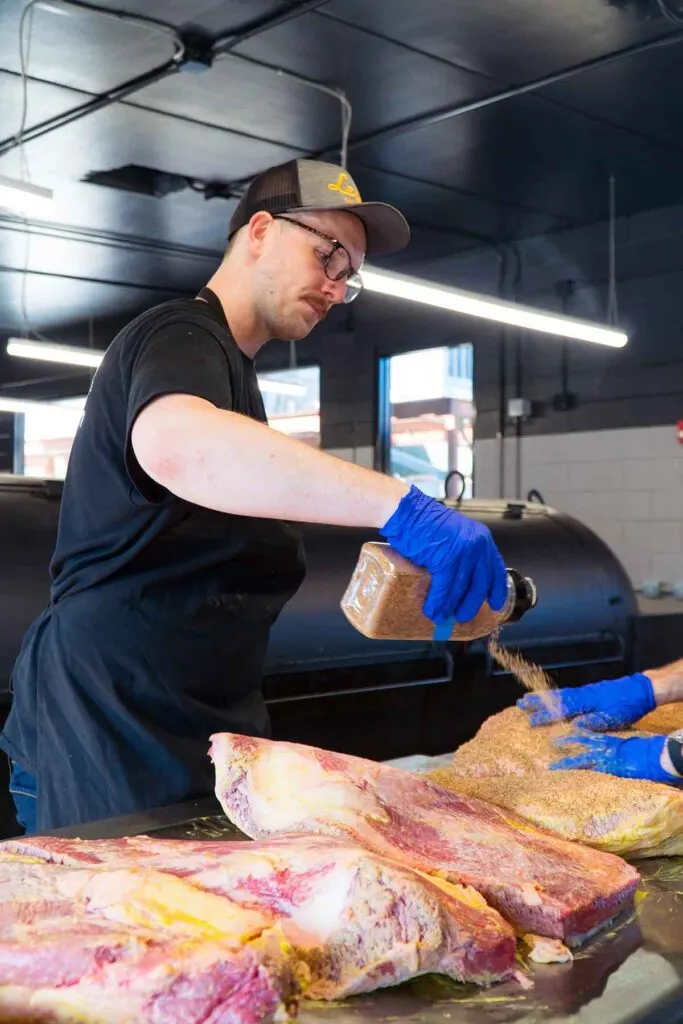
Photo courtesy of Lewis Barbecue. ProBros, photographer.
“Pretty much all our meat gets mustard on it,” Lewis told Eater about their smoked brisket. “It’s mustard and pickle juice. Mustard on its own is a little bit too thick. You end up with a pasty bark. So we cut it in half with pickle juice.”
“As far as if this is going to impart any sort of flavor, by the end of this long cook, it’s not noticeable. But what it does do is it helps the rub stick to the meat all over everywhere.”
“And you don’t have to like try to massage it into the meat or anything like that which is bad because then you’re closing the pores of the meat and then they can’t accept the smoke.”
Just remember to allow plenty of time for the meat to come to room temperature before placing it in the oven or smoker. When cooking, use low heat to slowly break down the collagen, ensuring a tender and succulent result.
Respected meat purveyor Snake River Farms agrees. They suggest the following:
“Prior to adding the brisket to the smoker, remove from refrigeration and allow it to rest, for at least 1-2 hours, at room temp to prepare it for the smoker. By adding a brisket that is close to room temperature to the smoker, it prevents a sudden drop in temperature of the smoker, adding to a longer cook time.”
Whether you’re slicing your cooked brisket to top a delicious pot roast or satisfying a craving for smoked BBQ, following these simple steps can lead to a flavorful, tender, and succulent dish that’s sure to impress.
Finishing and Serving Brisket

Resting and Slicing
After cooking a brisket, it’s essential to let it rest before slicing. This allows the juices to redistribute and the collagen, cartilage, and fat to further tenderize the meat. Resting the brisket for about an hour will lead to a juicier and more tender final product.
When slicing, always cut against the grain, which will shorten the muscle fibers and create more tender bites. The two main parts of brisket, point and flat, will have different grain directions, so adjust your slicing accordingly.
Burnt Ends
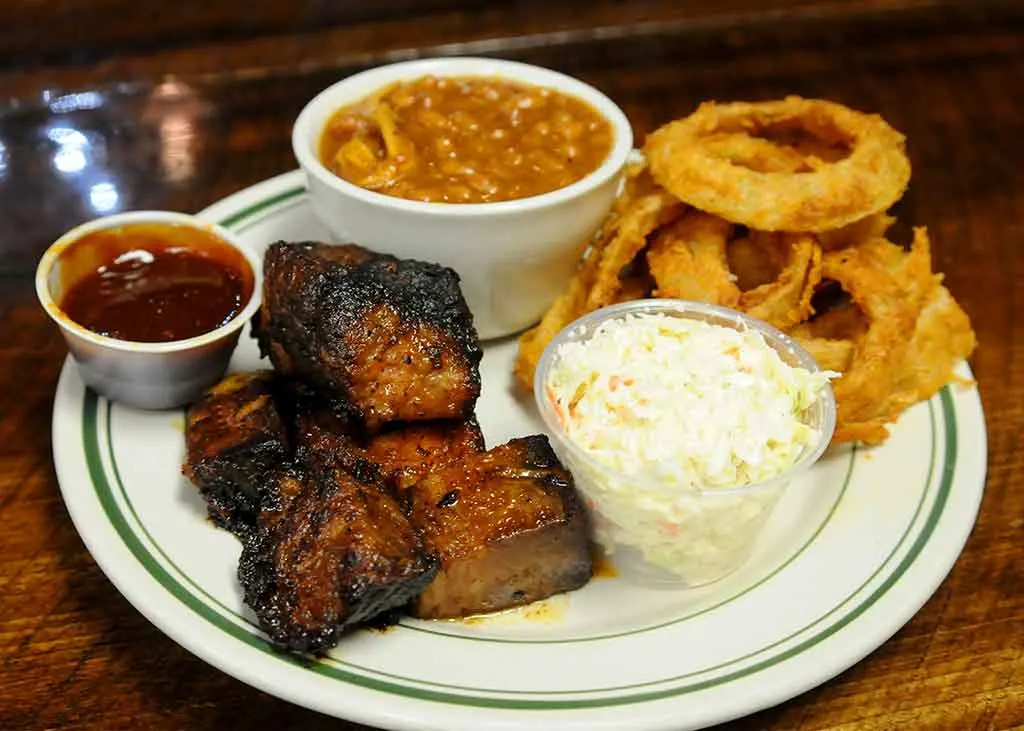
Burnt ends are delicious, caramelized morsels made from the brisket’s point. This cut has a higher fat content and more marbling, which makes it perfect for creating these tasty bites.
To create burnt ends, trim off the fat cap and cube the point into 1-inch pieces. Toss the pieces in your favorite barbecue sauce, and then return them to the smoker or oven for an additional hour or two, allowing the sauce to caramelize around the meat.
Sauce
While brisket is most often enjoyed on its own, many people serve it with a sauce to enhance its flavor. Classic options include a tangy barbecue sauce or a Texas-style mop sauce, which is a thinner, vinegar-based mixture.
These sauces can be brushed onto the brisket during the final stages of cooking or served on the side for dipping. Remember that sauce should complement the beef and not overpower it, so use it sparingly when serving.
In summary, when finishing and serving brisket, it’s crucial to rest the meat, slice against the grain, and consider options like burnt ends, and sauce. Utilizing methods like slow cookers and tenderizing agents can help create a delicious, tender final product that’s perfect for sharing at any gathering.
Brisket FAQ
The brisket is a cut of beef from the lower chest or breast section of the cow, situated beneath the first five ribs.
The point cut of the brisket is thicker, more marbled with fat, and often more flavorful, while the flat cut is leaner, thinner, and typically more uniform in shape.
The ideal cooking temperature for brisket is around 225-250 degrees Fahrenheit (107-121 degrees Celsius) in a slow cooker or smoker. Once cooked, the internal temperature should reach between 195-205 degrees Fahrenheit (90-96 degrees Celsius) for optimal tenderness.
You can tell when a brisket is done cooking by its internal temperature, which should be between 195-205 degrees Fahrenheit (90-96 degrees Celsius). Another good indicator is when the brisket offers little resistance when a toothpick or fork is inserted into it, indicating it’s tender enough.
If your brisket is tough, it could be because it was not cooked long enough or at a low enough temperature. Brisket is a dense cut of meat and needs a long, slow cooking process to break down the connective tissues. To make it tender, ensure you cook it slowly at a low temperature, keep it moist by basting, and let it rest before slicing.
To slice a brisket properly, identify the thinner flat and thicker point. These two sections typically have grains running in different directions. Start by slicing the flat against the grain into thin slices, usually 1/4 inch thick. When you reach the point, rotate the brisket since the grain of the point often shifts. Slice the point against the grain as well. Cutting against the grain ensures tender bites as it shortens the muscle fibers.
